Lectrosonics HMA9 Wireless Microphone Transmitter User Manual HMa 941 man indd
Lectrosonics Inc Wireless Microphone Transmitter HMa 941 man indd
Users Manual
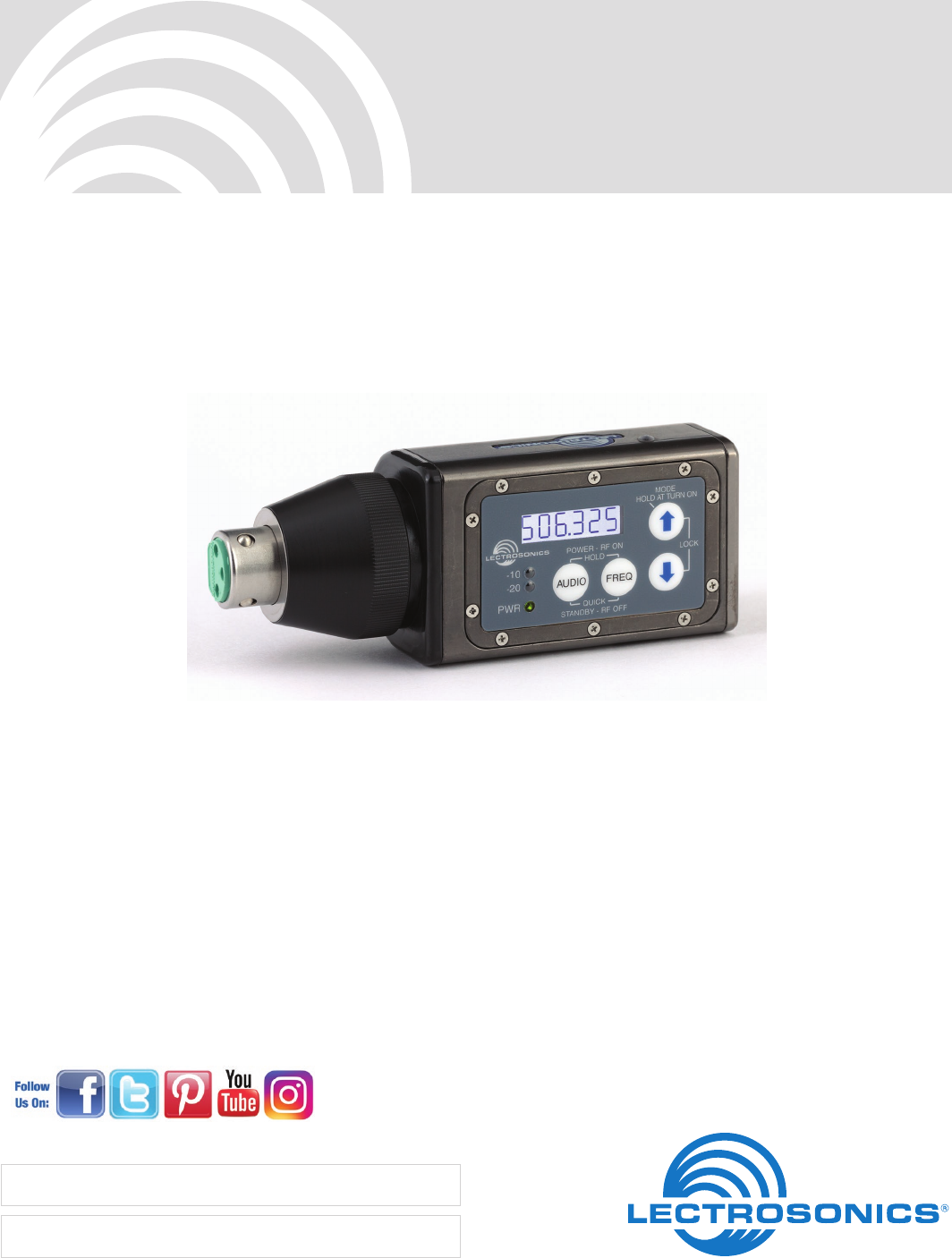
HMA-941 Series
Plug-on UHF Transmitter
INSTRUCTION MANUAL
Rio Rancho, NM, USA
www.lectrosonics.com
Fill in for your records:
Serial Number:
Purchase Date:
Digital Hybrid Wireless®
US Patent 7.225.135

HMa-941
LECTROSONICS, INC.
2
Introduction
Thank you for selecting a Lectrosonics HMa plug-On
transmitter. The unique design provides several distinct
features for professional applications:
• Outstanding RF operating range
• Superb audio quality
• Corrosion-resistant housing
• Programmable compatibility modes for use with a
variety of different receivers
The Digital Hybrid Wireless® design (US Patent
7,225,135) combines 24-bit digital audio with analog
FM resulting in a system that has the same operating
range as analog systems, the same spectral efficiency
as analog systems, the same long battery life as analog
systems, plus the excellent audio fidelity typical of pure
digital systems.
The transmitter uses a standard 3-pin XLR input jack for
use with any microphone with a a mating XLR connec-
tor. An LCD, membrane switches and multi-color LEDs
on the control panel make input gain adjustments and
frequency and compatibility mode selection quick and
accurate, without having to view the receiver. The hous-
ing is machined from a solid aluminum block to provide
a lightweight and rugged package. A special non-corro-
sive finish resists salt water exposure and perspiration
in extreme environments.
The DSP-based design works with Digital Hybrid
receivers, and is also compatible with Lectrosonics IFB
receivers. Companion receivers are covered in separate
manuals.

Plug-on UHF Transmitter
Rio Rancho, NM 3
For body worn operation, this transmitter has been tested
and meets the FCC RF exposure guidelines when used with
the Lectrosonics accessories supplied or designated for this
product. Use of other accessories may not ensure compliance
with FCC RF exposure guidelines. Contact Lectrosonics if
you have any questions or need more information about RF
exposure using this product..
This device complies with FCC radiation exposure limits as
set forth for an uncontrolled environment. This device should
be installed and operated so that its antenna(s) are not co-
located or operating in conjunction with any other antenna or
transmitter.
Table of Contents
Introduction .............................................................................. 2
General Technical Description ............................................... 4
Digital Hybrid Wireless® Technology ...................................... 4
Low Frequency Roll-Off ......................................................... 4
No Pre-Emphasis/De-Emphasis ............................................ 5
Input Limiter ........................................................................... 5
Signal Encoding and Pilot Tone ............................................. 5
Microprocessor and DSP ....................................................... 5
Compatibility Modes ............................................................... 5
Control Panel ......................................................................... 5
Controls and Functions .......................................................... 6
LCD Screen ........................................................................... 6
Power LED ............................................................................. 6
Audio Input Jack ..................................................................... 6
Battery Compartment............................................................. 6
Modulation LEDs .................................................................... 6
Audio Button .......................................................................... 6
Freq Button .................................................................... 6
UP/DOWN Arrows and Panel Lockout ................................... 6
Antenna .................................................................................. 6
Battery Installation .................................................................. 7
Attaching/Removing a Microphone ....................................... 7
Operating Instructions ............................................................ 8
Power Up and Boot Sequence ............................................... 8
Power Down ........................................................................... 8
Standby Mode ........................................................................ 8
Menus .................................................................................... 8
Hold UP arrow at turn on. ....................................................... 8
Hold DOWN arrow at turn on. ................................................ 9
FREQ Button ........................................................................ 10
Locking/Unlocking the Control Panel ................................... 10
Accessories ........................................................................... 11
P/N 21750 Barrel Adapter .................................................... 11
MCA-M30 Barrel Adapter ..................................................... 11
PHTRAN3 ............................................................................ 11
MCA5X ................................................................................. 11
MCA-TPOWER .................................................................... 11
Firmware Update ................................................................... 12
Specifications and Features ................................................. 14
Specifications ....................................................................... 14
Troubleshooting ..................................................................... 16
Service and Repair ................................................................ 18
Returning Units for Repair ................................................... 18
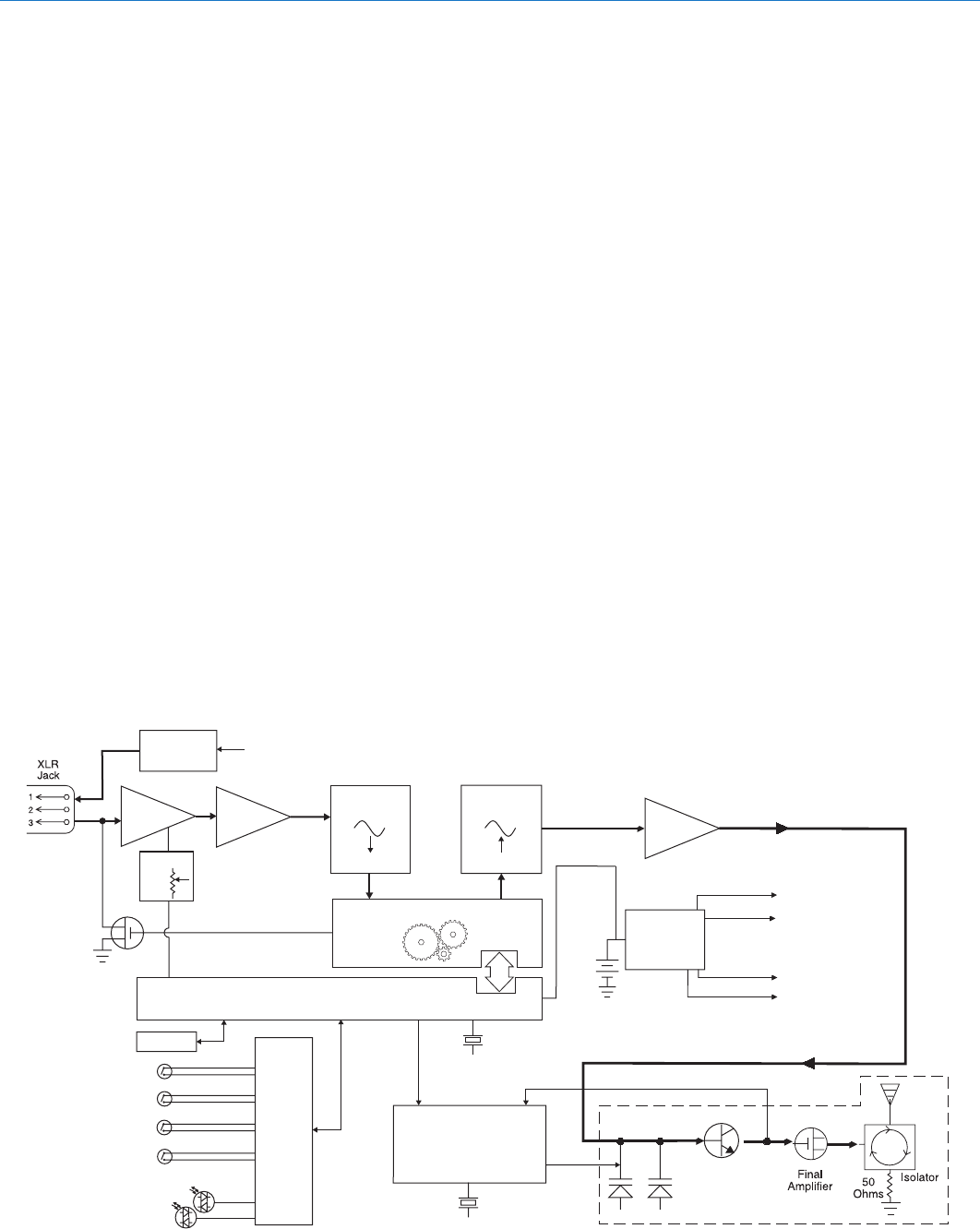
HMa-941
LECTROSONICS, INC.
4
General Technical Description
Bias Voltage
42V,15V, 5V
+4V
Input
Amp
Shunt
Limiter
AUDIO
FREQ
UP
DWN
Reference
Crystal
Reference
Crystal
3 V
Battery
Hi.Lo
Pass
Filter
Digital
PotAudio
Level
Phantom
Power
Audio A-D
Converter
11001001
D-A
Converter
11001001
Control Panel
Microprocessor
Voltage
Controlled
Oscillator
Filter
Amp
Encoded Audio
and Pilot Tone
Bicolor
Modulation
LEDs
Switching
Power
Supply
Digital Signal Processor
Phase Locked Loop
LCD
1.2V
4V
-3.3V
+3.3V
12 MHz
The DSP controlled input limiter features a wide range
dual envelope design which cleanly limits input signal
peaks up to 30 dB above full modulation. Switching
power supplies to provide constant voltages to the trans-
mitter circuits from the beginning (3 Volts) to the end (1.7
Volts) of battery life, and an ultra low noise input amplifier
for quiet operation.
Digital Hybrid Wireless® Technology
All wireless links suffer from channel noise to some de-
gree, and all wireless microphone systems seek to mini-
mize the impact of that noise on the desired signal. Con-
ventional analog systems use compandors for enhanced
dynamic range, at the cost of subtle artifacts (known as
“pumping” and “breathing”). Wholly digital systems defeat
the noise by sending the audio information in digital form,
at the cost of some combination of power, bandwidth and
resistance to interference.
Lectrosonics Digital Hybrid Wireless® systems over-
come channel noise in a dramatically new way, digitally
encoding the audio in the transmitter and decoding it
in the receiver, yet still sending the encoded informa-
tion via an analog FM wireless link. This proprietary
algorithm is not a digital implementation of an analog
compandor but a technique that can be accomplished
only in the digital domain, even though the inputs and
outputs are analog.
Channel noise still impacts received signal quality and
will eventually overwhelm a receiver. Digital Hybrid
Wireless® simply encodes the signal to use a noisy
channel as efficiently and robustly as possible, yield-
ing audio performance that rivals that of wholly digital
systems, without the power and bandwidth problems
inherent in digital transmission.
Because it uses an analog FM link, Digital Hybrid Wire-
less® enjoys all the benefits of conventional FM wire-
less systems, such as excellent range, efficient use of
RF spectrum, and resistance to interference. However,
unlike conventional FM systems, it does away with the
analog compandor and its artifacts.
Low Frequency Roll-Off
The low frequency roll-off can be set for a 3 dB down
point at 35, 50, 70, 100, 120 and 150 Hz to control sub-
sonic and very low frequency audio content in the au-
dio. The actual roll-off frequency will vary slightly depend-
ing upon the low frequency response of the microphone.
Excessive low frequency content can drive the trans-
mitter into limiting, or in the case of high level sound
systems, even cause damage to loudspeaker systems.
The roll-off is normally adjusted by ear while listening
as the system is operating.

Plug-on UHF Transmitter
Rio Rancho, NM 5
No Pre-Emphasis/De-Emphasis
The Digital Hybrid Wireless® design results in a signal-to-
noise ratio high enough to preclude the need for con-
ventional pre-emphasis (HF boost) in the transmitter and
de-emphasis (HF roll-off) in the receiver. This eliminates
the potential for distortion on signals with abundant
high-frequency information.
Input Limiter
A DSP-controlled analog audio limiter is employed
before the analog-to-digital (A-D) converter. The limiter
has a range of more than 30 dB for excellent overload
protection. A dual release envelope makes the limiter
acoustically transparent while maintaining low distor-
tion. It can be thought of as two limiters in series, a fast
attack and release limiter followed by a slow attack and
release limiter. The limiter recovers quickly from brief
transients, with no audible side effects, and also recov-
ers slowly from sustained high levels, to keep audio dis-
tortion low and while preserving short term dynamics.
Signal Encoding and Pilot Tone
In addition to controlling the limiter, the DSP also en-
codes the digitized audio from the A-D converter and
adds an ultrasonic pilot tone to control the receiver’s
squelch. A pilot tone squelch system provides a reliable
method of keeping a receiver output muted (squelched)
even in the presence of significant interference. When
the system is operating in the hybrid mode, a differ-
ent pilot tone frequency is generated for each carrier
frequency in 100 kHz increments to prevent inadvertent
squelch problems and simplify frequency coordination.
Microprocessor and DSP
A microprocessor monitors user command inputs from
the control panel buttons and numerous other internal
signals. It works intimately with the DSP to ensure the
audio is encoded according to the selected Compatibil-
ity Mode and that the correct pilot tone is added to the
encoded signal.
Compatibility Modes
The transmitter was designed to operate with Lectroson-
ics Digital Hybrid Wireless® receivers and will yield the
best performance when doing so. However, due to the
flexibility of digital signal processing, the transmitter can
also operate with Lectrosonics IFB receivers that may
be available in the future.
Control Panel
The control panel includes four membrane switches and
an LCD screen to adjust the operational settings. Multi-
color LEDs are used to indicate audio signal levels for
accurate gain adjustment and for battery status.
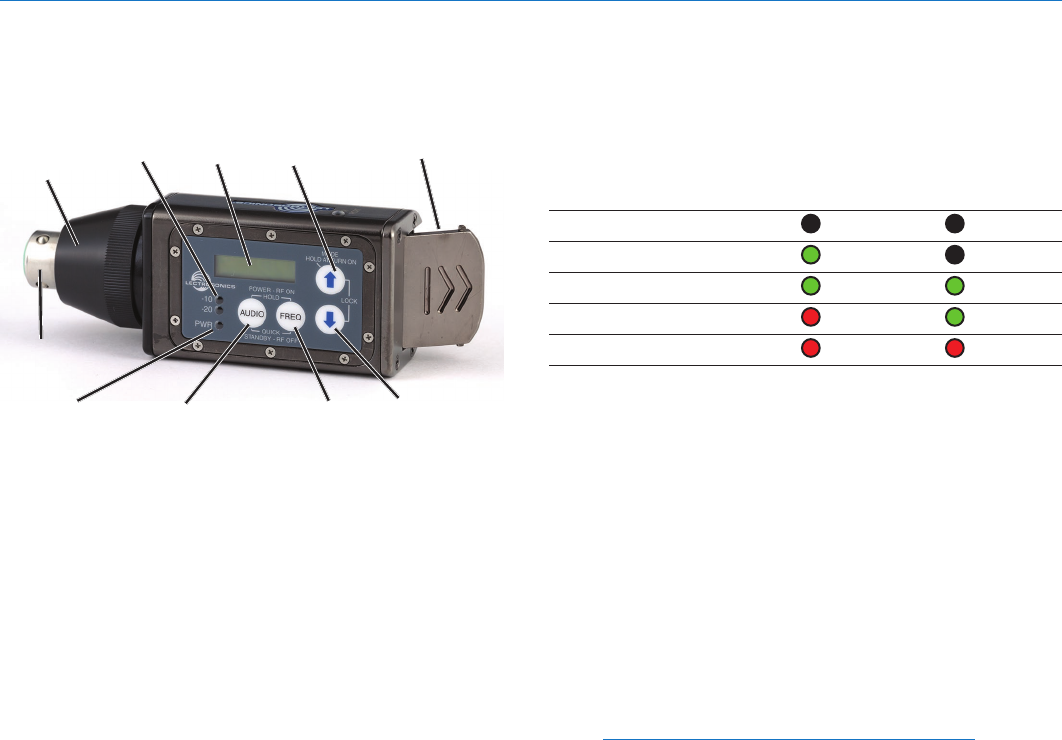
HMa-941
LECTROSONICS, INC.
6
Controls and Functions
LCD Screen
The LCD is a numeric-type Liquid Crystal Display with
several screens that allow settings to be made with the
AUDIO and FREQ buttons, and the UP and DOWN ar-
row buttons to configure the transmitter. The transmitter
can be turned on in a “standby” mode with the carrier
turned off to make adjustments without the risk of inter-
fering with other wireless systems nearby.
Power LED
The PWR LED glows green when the batteries are
good. The color changes to red when there is about 20
minutes of life left. When the LED begins to blink red,
there are only a few minutes of life.
A weak battery will sometimes cause the PWR LED to
glow green immediately after being put into the unit, but
will soon discharge to the point where the LED will go
red or shut off completely.
Audio Input Jack
The XLR input jack on the transmitter accommodates
hand-held, shotgun and measurement microphones.
Phantom power can be set at various levels for use with
a wide variety of electret microphones.
Battery Compartment
The battery compartment door is made of machined
aluminum and is hinged to the housing to prevent it be-
ing damaged or lost.
Modulation LEDs
The Modulation LEDs provide a visual indication of the
input audio signal level from the microphone. These two
bicolor LEDs can glow either red or green to indicate
modulation levels. Full modulation (0 dB) occurs when
the -20 LED first turns red.
Signal Level -20 LED -10 LED
Less than -20 dB Off Off
-20 dB to -10 dB Green Off
-10 dB to +0 dB Green Green
+0 dB to +10 dB Red Green
Greater than +10 dB Red Red
Audio Button
The AUDIO button is used to display the audio level set-
ting, low frequency roll-off and phantom power mode.
Repeatedly pressing the button will cycle through the
available settings, allowing the UP and DOWN arrow
buttons to adjust the values.
Freq Button
The FREQ Button displays the selected operating
frequency and also toggles the LCD between displaying
the actual operating frequency in MHz and a two-digit
hexadecimal number. Frequencies can be selected in
either 100kHz or 25kHz steps. The appearance of the
hexadecimal number is different in the 100kHz step size
mode than in the 25kHz step size mode.
NOTE: The FREQ and AUDIO buttons are used
together to enter the standby mode and to turn the
power on or off.
UP/DOWN Arrows and Panel Lockout
The UP and DOWN arrow buttons are used to select
the operating frequency, adjust the audio level, or set
the Compatibility Mode.
Pressing both arrows simultaneously enters the lock
countdown. Holding the two buttons in until the count-
down is completed locks the control panel buttons so
they can only be used to display current settings. “Loc”
is displayed to indicate the controls are locked when a
button is pressed while the panel is locked.
Once locked, the control panel is unlocked by removing
the battery or using the remote control “dweedle” tones.
Antenna
An antenna is formed between the housing and the
attached microphone, operating much like a dipole. At
UHF frequencies the length of the housing is similar
to 1/4 wavelength of the operating frequency, so the
antenna is surprisingly efficient, which helps extend the
operating range and suppress noise and interference.
Battery
Compartment
XLR Input Jack
AUDIO Button
LCD
Input
Coupler
FREQ Button
Modulation
LEDs
PWR LED
UP Arrow
DOWN Arrow
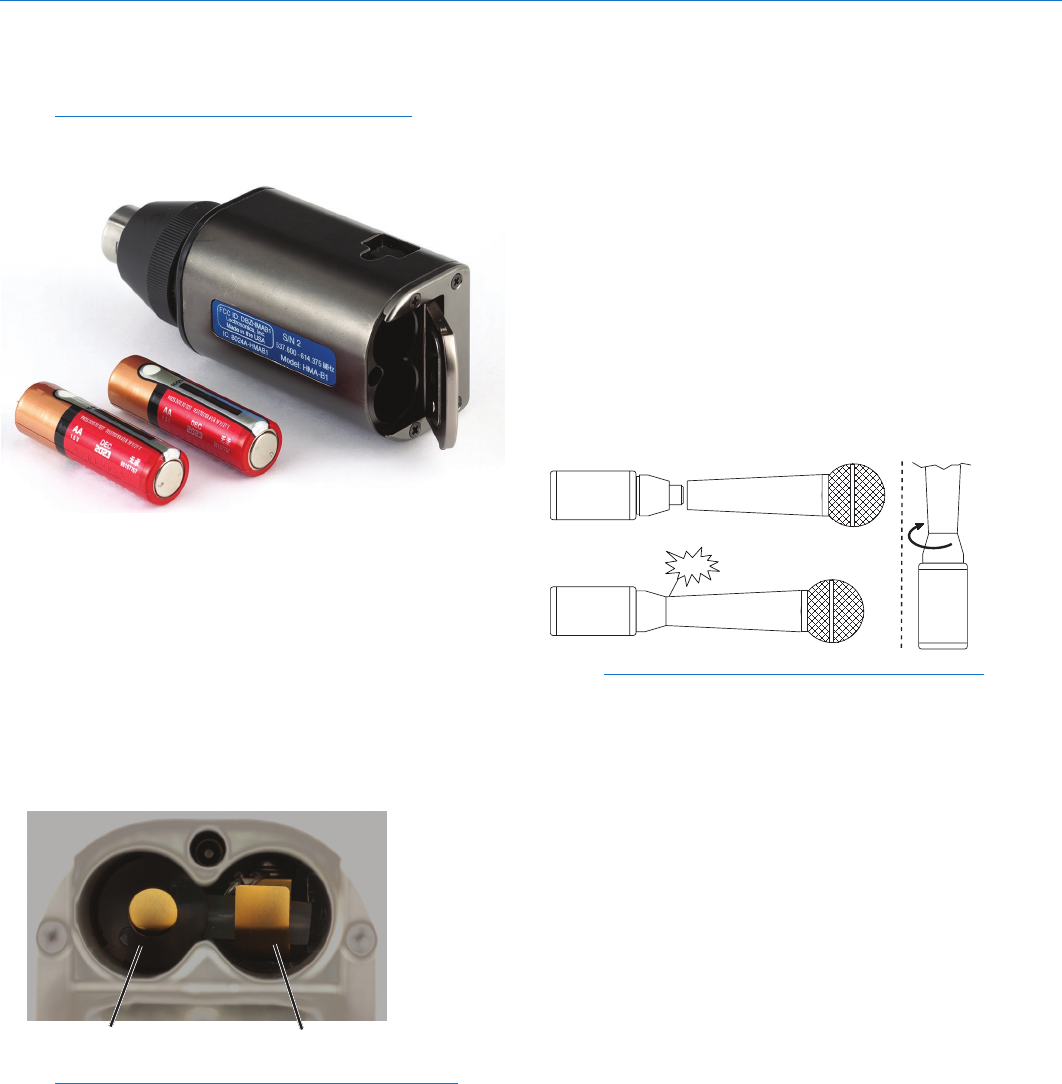
Plug-on UHF Transmitter
Rio Rancho, NM 7
Battery Installation
The transmitter is powered by two AA batteries.
Note: Standard zinc-carbon batteries marked
“heavy-duty” or “long-lasting” are not adequate.
Batteries operate in series, with a connecting plate
built into the battery door
To install new batteries:
1. Slide open the Battery Cover and remove any old
batteries.
2. Insert the new batteries into the housing. One bat-
tery goes in positive (+) end first, the other negative
(-) end first. Look into the battery compartment to
determine which end goes in which side. The side
with the circular insulator is the side which accepts
the positive end of the battery.
positive (+)
terminal
negative (–)
terminal
Note: It is possible to install the batteries backward
and close the battery door, but the batteries will
not make contact and the unit will not work.
3. Slide the Battery Cover until it snaps securely shut.
Attaching/Removing a
Microphone
The spring loaded coupler under the XLR jack main-
tains a secure fit to the microphone jack with continu-
ous pressure applied by an internal spring.
To attach the microphone, simply align the XLR pins
and press the microphone onto the transmitter until
the coupler retracts and latches. A click sound will be
heard as the connector latches.
To remove the microphone, hold the transmitter body
in one hand with the microphone pointing upward. Use
your other hand to rotate the coupler until the latch
releases and the coupler rises slightly.
Do not pull on the microphone while releasing the
locking collar.
TO AT TA CH
TO REMOVE
Hold the
transmitter
case with the
microphone
pointed
upward.
Rotate the
collar in the
direction
shown.
Pull on mic to ensure it is locked.
Press firmly, listen for click.
Depress collar fully.
Click!
NOTE: Do not hold or apply any pressure to the
microphone body while trying to remove it, as
this may prevent the latch from releasing.
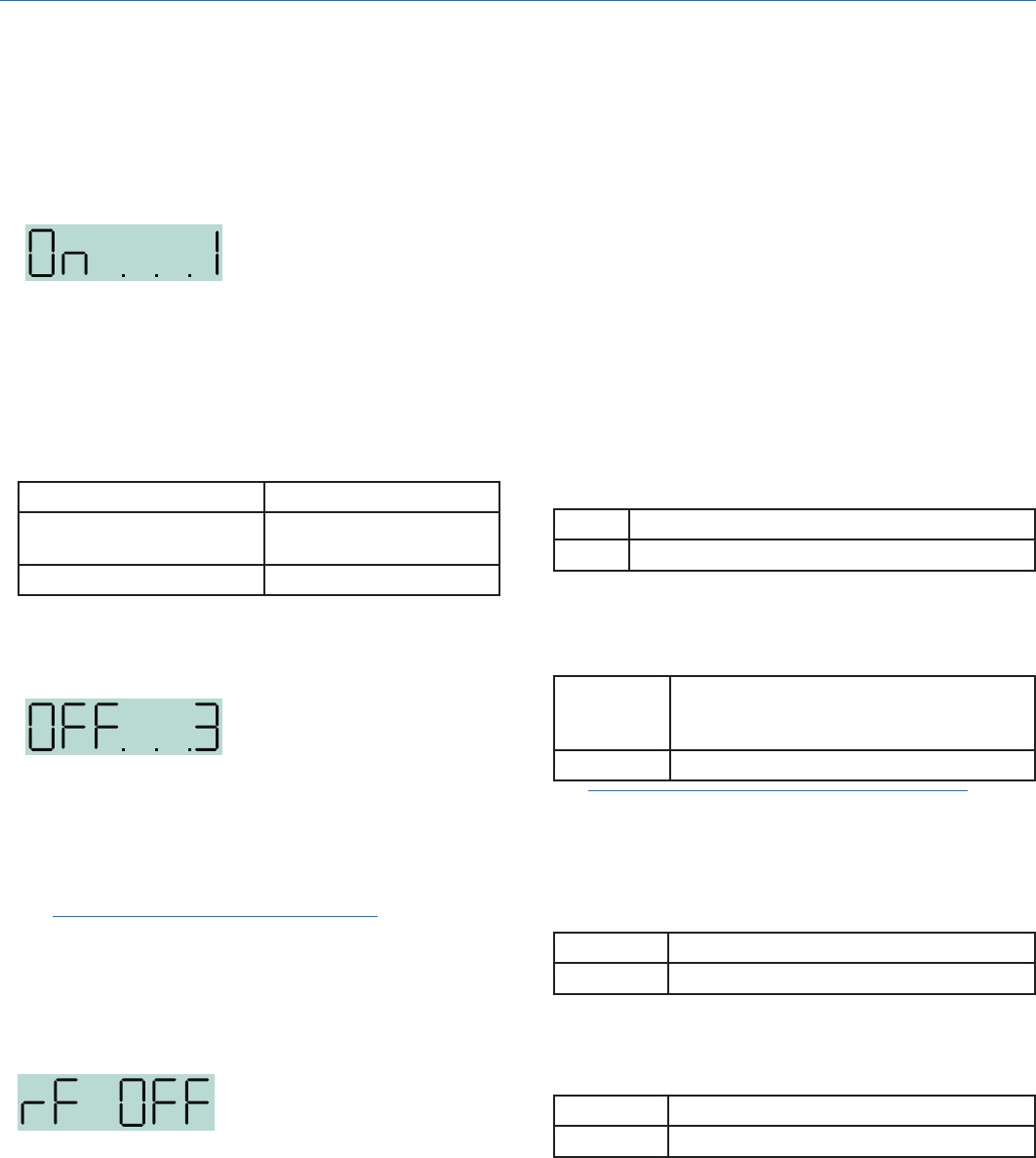
HMa-941
LECTROSONICS, INC.
8
Operating Instructions
Power Up and Boot Sequence
1) Ensure that good batteries are installed in the unit.
2) Simultaneously press and hold the AUDIO and
FREQ buttons until the power on boot sequence is
initiated.
The count will progress from 1
through 3 and the unit will then
power up with the RF output
turned on. During this turn on sequence, the
modulation and power LEDs all glow red, then
green, and then revert to normal operation. If the
buttons are released before the count is complete,
the unit will boot up into the standby mode (see
below).
The LCD displays the following information during
the boot sequence:
Company Name: LECtro
Frequency Block and
Firmware Version (rX.X):
941r1.1 (typical)
Compatibility Mode: CP nHb (typical)
When the boot sequence is complete, the display will
switch to the frequency currently set.
Power Down
Initial Power Off
Timer Screen
1) Simultaneously press and hold the AUDIO and
FREQ buttons while observing that the word “Off”
appears in the LCD along with a counter.
2) When the counter reaches “0”, the unit turns off.
Note: If the AUDIO and FREQ buttons are
released before the LCD goes blank at the end of
the countdown, the unit will not turn off. Instead, it
will stay energized and the display will return to the
previous screen.
Standby Mode
Standby Screen
With the power turned off,
pressing the AUDIO and
FREQ buttons briefly places
the unit in Standby Mode.
In this mode the RF output is turned off so all setup
adjustments can be made without interfering with other
systems operating in the same location. The screen
displays “rf OFF” to remind the user that the unit is not
transmitting.
While the unit is in the standby mode, access the setup
screens using the AUDIO and FREQ buttons and make
adjustments using the UP and DOWN arrows.
Menus
Setup is accomplished using menus and setup screens
accessed by holding the UP and DOWN arrow buttons
at turn on, and by pressing the AUDIO and FREQ but-
tons when the unit is turned on.
Hold UP arrow at turn on.
Hold the UP arrow button in while pressing both AUDIO
and FREQ buttons to access the setup screens below.
It’s easier if you lay the unit on a flat surface and use
two hands to press all three buttons at the same time.
After the first screen loads, press the AUDIO button
repeatedly to switch between the settings. Press the UP
and DOWN arrow buttons for the desired selection.
After the settings are made, press both AUDIO and
FREQ buttons together to exit and turn the power off.
CP (compatibility modes)
Allows the transmitter to be used with 941 Series re-
ceivers or IFB systems in the 941 MHz band.
nHb Digital hybrid mode
IFb Lectrosonics IFB systems
Pr (power output)
Can be set at 250 for extended range or at 50 for longer
battery life.
50 50 mW output and longer battery life
when maximum range is not neces-
sary
100 100 mW for slightly increased range
NOTE: See battery life table in the specifications
AP (audio polarity)
The polarity of the audio input (sometimes referred to
as “phase”) can be reversed for compatibility with other
microphones.
PDenotes positive polarity
nDenotes negative polarity
StP (Frequency step size)
Sets the increments of frequency adjustment.
100 100 kHz steps
25 25 kHz steps
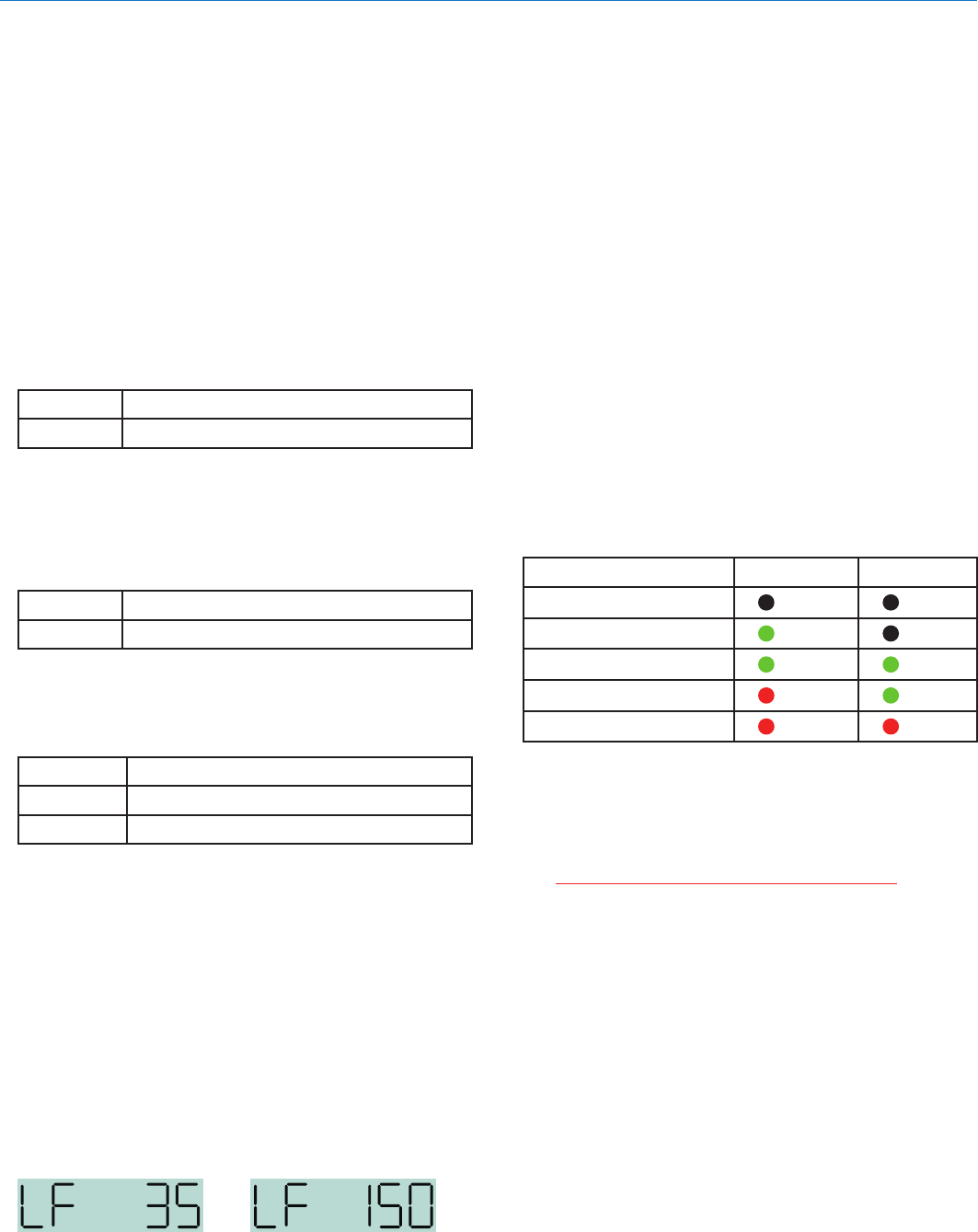
Plug-on UHF Transmitter
Rio Rancho, NM 9
Hold DOWN arrow at turn on.
Hold the DOWN arrow button in while pressing both
AUDIO and FREQ buttons to access the setup screens
below. It’s easier if you lay the unit on a flat surface and
use two hands to press all three buttons at the same
time. After the first screen loads, press the AUDIO but-
ton repeatedly to switch between the settings. Press the
UP and DOWN arrow buttons for the desired selection.
After the settings are made, press both AUDIO and
FREQ buttons together to exit and turn the power off.
rc (remote control with mobile app)
Allows the transmitter to respond to remote control
“dweedle” tones from a mobile device, or from tones
generated by the Lectrosonics RM and RM2 devices.
on Enables the remote function.
oFF Disables the remote function.
PbAc (auto power restore)
Sets the transmitter to automatically turn back on and
return to the previous state after a battery change or
power interruption when it is in the operating mode.
1 Restores power automatically
0 Does not restore power automatically
bL (backlight settings)
Adjusts how long the LCD stays lit after pressing
buttons.
55 minutes
30 30 seconds
on Stays on
AUDIO Button
When the unit is turned on in either the Standby or
Operating Mode, pressing the AUDIO button repeatedly
switches between the available settings.
• LF (XX) adjusts the low frequency roll-off of the
audio signal.
• AUD (XX) adjusts the input gain
LF (XX) - Adjusting the Low Frequency Roll-off
Repeatedly press the AUDIO button until the LF roll-
off adjustment screen appears. Then press and hold
the AUDIO button while selecting the desired roll-off
frequency with the UP and DOWN arrows.
The roll-off frequency can be set to 35, 50, 70, 100, 120
and 150 Hz.
AUD (XX) - Adjusting Audio Level (Gain)
It’s generally a good idea to adjust the low frequency
roll-off before setting the gain, since it could affect the
gain adjustment. The control panel modulation LEDs
marked -10 and -20 indicate the audio level and lim-
iter activity. Once adjusted according to the following
procedure, the transmitter’s audio level setting should
not be used to control the volume of your sound system
or recorder levels. This gain adjustment matches the
transmitter gain with the microphone’s output level, the
user’s voice level and the position of the microphone.
The audio input level (gain) should be adjusted with the
unit in the Standby Mode while observing the LEDs.
It is generally best to set the LF roll-off before adjust-
ing the gain, since low frequency energy can affect the
input level to the transmitter.
It is desirable to to set the gain so that some limiting
occurs on louder peaks. The limiter is very transparent
over a 43 dB range, and its effect is not audible until the
system is close to overload. In other words, don’t be shy
about turning up the gain.
It is actually a good idea to turn the gain up to maxi-
mum and listen for distortion or compression to get a
feel for how much headroom is available.
Signal Level -20 LED -10 LED
Less than -20 dB Off Off
-20 dB to -10 dB Green Off
-10 dB to +0 dB Green Green
+0 dB to +10 dB Red Green
Greater than +10 dB Red Red
Note: If several different people will be using the transmitter
and there is not time to make the adjustment for each indi-
vidual, adjust it for the loudest voice.
1) With the transmitter in the Standby Mode, plug in
the microphone and make sure the connector is
firmly seated.
Warning: If the wireless system is powered
up while connected to a live sound system, be
careful to turn the sound system level down
first or severe feedback can occur.
2) Position the microphone in the location where it will
be used in actual operation.
3) Observe the modulation LEDs while speaking or
singing into the microphone at the same voice level
that will be used during operation. While holding
the AUDIO button, press the UP or DOWN arrow
buttons until the both the -20 and -10 LEDs glow
green, with the -20 LED flickering red during louder
peaks in the audio. This will maximize the signal to
noise ratio of the system with full modulation.
4) If the unit was set up in Standby Mode, it will be
necessary to turn the transmitter off, then power it
up again in normal operation so the RF output will
be on. Then the other components in the sound or
recording system can be adjusted.

HMa-941
LECTROSONICS, INC.
10
PH (phantom power supply)
The transmitter input jack can provide phantom power
for the attached microphone if needed, with voltages
at 5, 15 or 48 or be turned off. Use the UP and DOWN
arrow buttons to select the desired setting. Phantom
power will consume a slight amount of battery power.
About the Phantom Power Supply
Three phantom voltages are selectable from the control
panel. The voltages are:
• 5 Volts for lavaliere microphones,
• 15 Volts for some professional mics requiring high
current and for many common stage mics that will
operate over a wide phantom Voltage range of 12 to
48 Volts. With the proper adapter, this position can
also be used with T power microphones. See our
web site for details on finding or making the proper
adapter.
• 48 Volts for microphones that do in fact require a
supply greater than 18 Volts. (See below for a dis-
cussion of why 42 and not a “true” 48 Volts.)
For longest battery life use the minimum phantom volt-
age necessary for the microphone. Many stage micro-
phones regulate the 48 Volts down to 10 Volts internally
anyway, so you might as well use the 15 Volt setting and
save some battery power. If you are not using a micro-
phone for the input device, or are using a microphone
that does not require phantom power, turn the phantom
power off.
Phantom power should only be used with a fully float-
ing, balanced device such as most microphones with
a 3-pin XLR connector. If you use the phantom power
with an unbalanced device or if pins 2 or 3 are DC con-
nected to ground, then you will draw maximum current
from the power supply. The HM is fully protected against
such shorts but the batteries will be drained at twice the
normal rate.
The transmitter can supply 4 mA at 42 Volts, 8 mA at 15
Volts, and 8 mA at 5 Volts. The 42 Volts setting actually
supplies the same voltage to a 48 Volt microphone as
the DIN standard arrangement due to a dynamic bias-
ing scheme that does not have as much voltage drop
as the DIN standard. The 48 Volt DIN standard arrange-
ment protects against shorts and high fault current with
high resistance in the power supply feeds to pins 2 and
3. This provides protection if the supply current is ac-
cidentally shorted to ground and also keeps the micro-
phone from being attenuated by the power supply.
The HMa improves on those functions and is able to
use less power from the battery by using constant
current sources and current limiters. With this dynamic
arrangement the HMa can also supply more than twice
the current of competing 48 Volt plug on units and pro-
vide four times the current for some very high end 15
Volt microphones.
FREQ Button
The operating frequency can be adjusted according to
the frequency in MHz or a two-digit hexadecimal code.
Press the button repeatedly to switch between the two
displays. The display switches when the button is first
pushed; push and hold the button in the desired mode
and use the UP and DOWN arrow buttons to make the
adjustment.
Hex code numbering came about years ago when the
first synthesized wireless equipment was introduced.
Two 16-position rotary switches were used to set the
frequency. 16 on one switch and 16 on the other switch
yielded 256 frequencies (16x16=256). While there are
no 941 band models that use these switches, hex code
numbering is easier way to remember than frequencies
expressed in MHz with six numerals.
In this example, the same frequency is displayed in
MHz and the equivalent hex code.
The hex code is a hexadecimal numbering sequence
that progresses upward from lowest to highest fre-
quency using the numerals and letters from 0 through
F. When the frequency is on a 100 kHz step, the hex
code will display two 00’s for the last two digits, which
is easy to remember (3A in the example above). When
the step size is set to 25 kHz, the last two digits will be
00, 25, 50 or 75 (3A.25 in the example below), which
is still easier to remember than all six numerals of the
frequency in MHz.
Locking/Unlocking the Control Panel
Simultaneously pressing and
holding both the UP and
DOWN arrow buttons during
normal operation starts the
Lock timer. The timer starts at
three and counts down to zero.
When the timer reaches zero, the buttons on the control
panel are locked.
With the controls locked, the AUDIO and FREQ buttons
can still be used to display current settings. Any attempt
to change a setting by pressing either the UP or DOWN
arrow button will result in an on-screen reminder (Loc)
that the controls are locked. Remove the batteries to
unlock the control panel.
Important: Once the transmitter is locked, it
cannot be unlocked or powered off using the
buttons. The only ways to unlock a locked
transmitter are to remove the battery or unlock it
via the remote control.
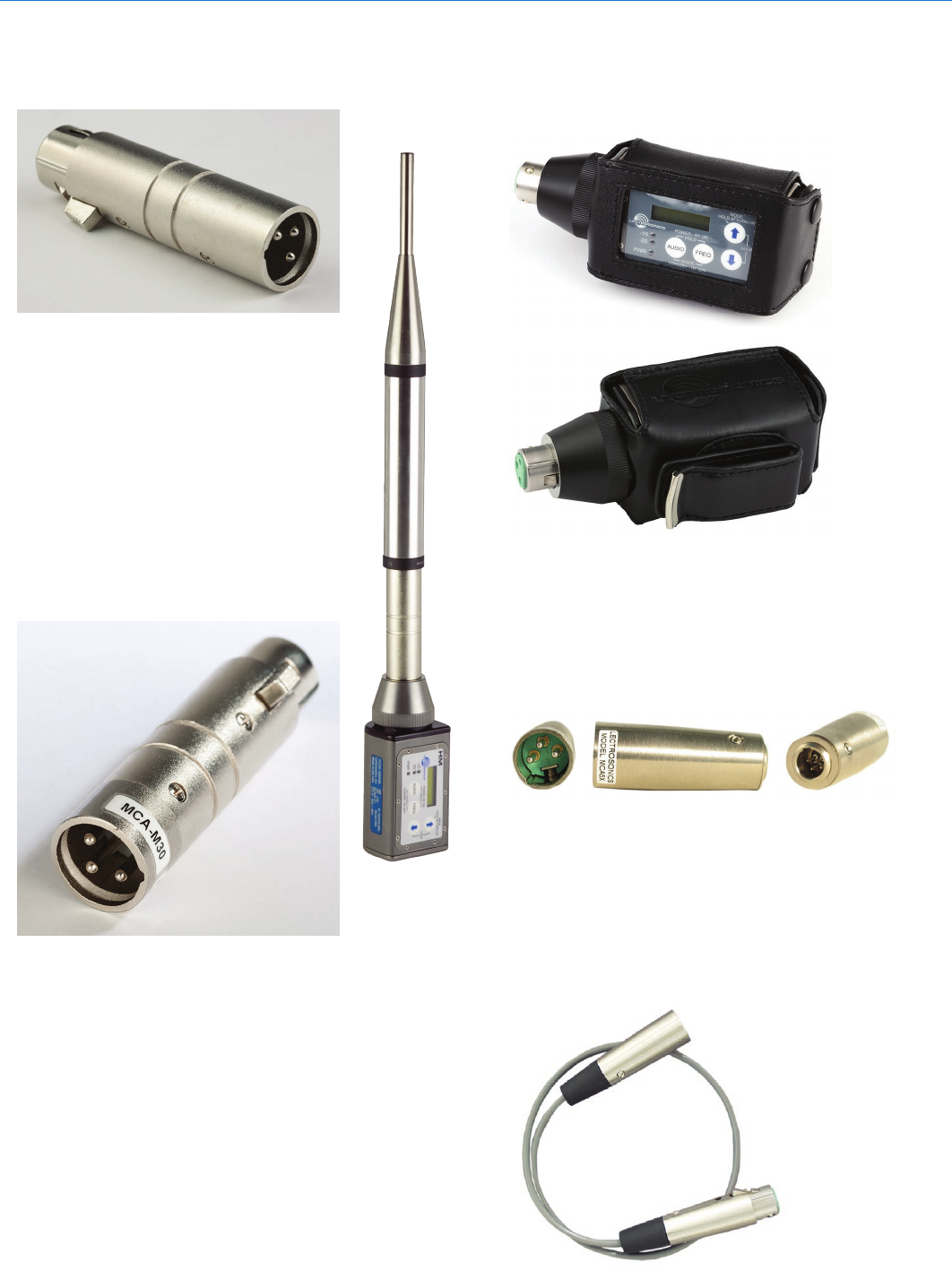
Plug-on UHF Transmitter
Rio Rancho, NM 11
Accessories
P/N 21750 Barrel Adapter
Mic adapter for Earthworks M30 micro-
phone with HM, HMa and UH400a/TM
transmitters.
This polarity reversing adapter may
be needed to correct for asymmetrical
current draw in some P48 powered
condenser microphones, including older
Neumann 100 Series, Rode NTG3 and
others. If your microphone does not
power on correctly when used with these
transmitters, insert the adapter between
the transmitter and microphone.
MCA-M30 Barrel Adapter
This adapter may be needed if you are experiencing
noise or distortion with measurement microphones, par-
ticularly the Earthworks M30. The adapter has common
mode checks for suppressing RF noise. If your micro-
phone signal exhibits the problems listed above when
connected to a UH400, HM or HMa transmitter, insert
the adapter between the microphone and the transmit-
ter.
Insert the adapter between the transmitter and micro-
phone to alleviate the problems listed above.
Barrel Adapter Earthworks M30
PHTRAN3
Replacement leather pouch with clear plastic screen
cover, rotating belt clip and snap closure. Included with
transmitter at purchase.
MCA5X
Optional adapter for connecting a lavaliere microphone
to the HMa or HM transmitters. TA5M to XLR3-M
connectors. Passes transmitter phantom power to
bias the electret lavaliere microphone. Includes zener
protection to limit bias voltage to protect the microphone
if transmitter phantom power is set too high.
MCA-TPOWER
This cable adapter is to be used with the UH200D,
UH400, HM and HMa plug-on transmitters with
T-powered microphones. It will protect a T-power
mic against the 48V phantom power setting in the
transmitter while allowing normal operation. The
transmitter should be set to the 15V position for best
operation and minimum battery drain.
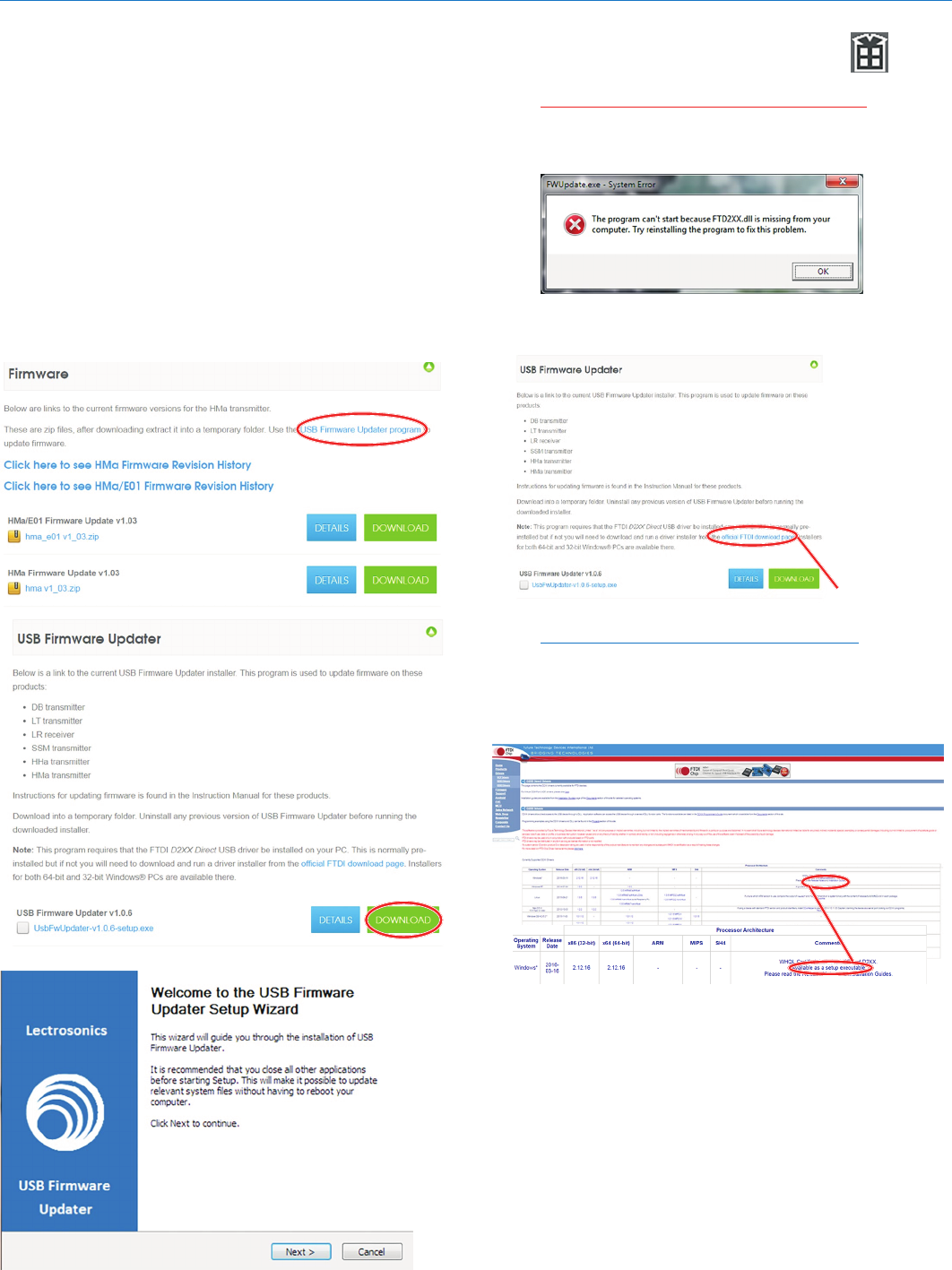
HMa-941
LECTROSONICS, INC.
12
Firmware Update
Updating the firmware is a simple matter of download-
ing a utility program and file from the website and
running the program on a Windows operating system
with the transmitter connected to a computer via the
USB port.
Go to www.lectrosonics.com/US. In the top menu, hover
the mouse over Support, and click on Wireless Support.
On the right-hand-side Wireless Support Menu, choose
Wireless Downloads. Choose your product (HMa), then
choose Firmware.
Step 1:
Begin by downloading the USB Firmware Updater
Program.
Step 2:
Next, test the Updater by opening the icon: If the
driver opens automatically, proceed to Step 3.
WARNING: If you receive the following error, the
Updater is not installed on your system. Follow the
TROUBLESHOOTING steps to fix the error.
TROUBLESHOOTING:
If you receive
the FTDI
D2XX error
shown
above,
download
and install
the driver by
clicking on
this link.
Then click here to download.
NOTE: This website, http://www.ftdichip.com/
Drivers/D2XX.htm, is not associated with
Lectrosonics.com. It is a third party site used
only for D2XX drivers currently available for
Lectrosonics’ devices’ upgrades.
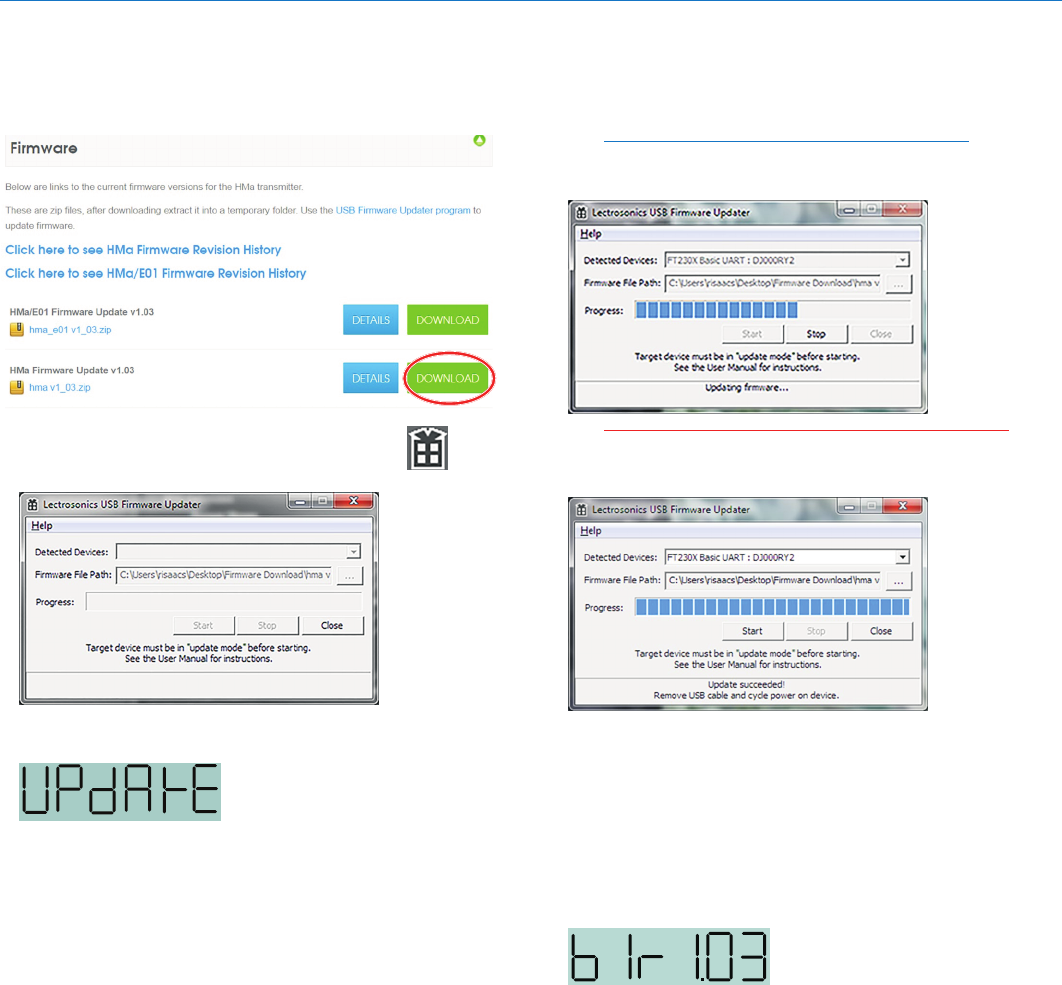
Plug-on UHF Transmitter
Rio Rancho, NM 13
Step 3:
Refer to Step 1 to return to Firmware web page. Down-
load Firmware Update and save to a local file on your
PC for easy locating when updating.
Step 4:
Open Lectrosonics USB Firmware Updater.
Step 5:
With the unit powered OFF,
put the transmitter in UPDATE
mode by simultaneously
holding down the UP arrow,
DOWN arrow, AUDIO and
FREQ buttons.
Step 6:
Using a microUSB cable, connect the transmitter to
your PC.
Step 7:
In Lectrosonics USB Firmware Updater, choose the
detected device, browse to local Firmware File and click
Start.
NOTE: It may take up to a minute or so for the
Updater to recognize the transmitter.
WARNING: Do not disrupt the microUSB cable during
updating.
The Updater alerts with progress and completion.
Step 8:
Once the Updater has completed, turn off the trans-
mitter, then turn it back on to verify that the firmware
version on the transmitter LCD matches the firmware
version shown on the web site. The firmware is the sec-
ond LCD display during bootup sequence.
Step 9:
Close Updater and disconnect microUSB cable.

HMa-941
LECTROSONICS, INC.
14
Specifications and Features
Digital Hybrid Wireless® is a revolutionary design
that combines digital audio with an analog FM radio
link to provide outstanding audio quality and the
exemplary RF performance of the finest analog
wireless systems.
The design overcomes channel noise in a dramati-
cally different way, digitally encoding the audio in
the transmitter and decoding it in the receiver, yet
still sending the encoded information via an analog
FM wireless link. This proprietary algorithm is not a
digital implementation of an analog compandor. In-
stead, it is a technique which can be accomplished
only in the digital domain.
The process eliminates compandor artifacts,
expanding the applications to include test and mea-
surement of acoustic spaces.
*US Patent 7,225,135
Specifications
Operating Frequency Range: 941.525 - 951.975 MHz
952.875 - 956.225 MHz
956.475 - 959.825 MHz
Frequency Selection Steps: Selectable; 100 kHz or 25 kHz
RF Power output: Selectable 50/100 mW
Pilot tone: 27 to 32 kHz; 3.0 kHz deviation
(in the Digital Hybrid mode)
Frequency stability: ± 0.002%
Spurious radiation: Compliant with ETSI EN 300 422-1 v1.4.2
Equivalent input noise: –125 dBV (A-weighted)
Input level: Nominal 2 mV to 300 mV, before limiting.
Greater than 1V maximum, with limiting.
Input impedance: 300 Ohms
Input limiter: Dual envelope “soft” limiter; greater than 30
dB range
Gain control range: 55 dB; panel mounted membrane switches
Modulation indicators: Dual bi-color LEDs indicate modulation of
-20, -10, 0, +10 dB referenced to full
modulation
Audio Performance (overall system):
Frequency Response: 35 Hz to 20 kHz (+/-1dB)
Low frequency Roll-off: Adjustable for -3dB
@30, 50, 70, 100, 120 or 150 Hz)
THD: 0.2% (typ.) 100 Hz to 20 kHz
System Dynamic Range:
SmartNR no limiting w/limiting
OFF 103.5 108.0
NORMAL 107.0 111.5
FULL 108.5 113.0
Note: The dual envelope “soft” limiter
provides exceptionally good handling of
transients using variable attack and release
time constants.
Once activated, the limiter compresses 30+
dB of transmitter input range into 4.5 dB of receiver output range, thus reducing the measured
figure for SNR without limiting by 4.5 dB.
Controls & Indicators: • Power/Phantom “ON-OFF”
• Phantom voltage selector
• Audio input gain
• LCD w/membrane switches
• LED audio level indicators
Audio Input Jack: Standard 3-pin XLR (female)
Phantom Power: 5V @ 18 mA max., 15V @ 15 mA max.
and 48 V @ 4 mA max., plus “OFF”
USB port: Used for firmware updates
IR (infrared) port: For quick setup by transferring settings from
an IR enabled receiver
Antenna: Housing and attached microphone/cable
form the antenna
Battery: Two 1.5 Volt AA alkaline
Battery Life (Duracell Quantum):
AA alkaline; No Phantom Power: 5h 0m*
AA alkaline; 48V Phantom Power: 3h 30m**
*Tested with a dynamic microphone
**Tested with a Sanken CS1 for a phantom-powered microphone
Weight: 6.7 oz (190 grams) without batteries
Dimensions: 4.25x1.62x1.38 inches
Emission Designator: 180KF3E

Plug-on UHF Transmitter
Rio Rancho, NM 15

HMa-941
LECTROSONICS, INC.
16
Before going through the following chart, be sure that you have a good battery in the transmitter. It is important that you
follow these steps in the sequence listed.
SYMPTOM POSSIBLE CAUSE
TRANSMITTER PWR LED OFF 1) Battery is inserted backwards or dead.
2) Transmitter not powered up.
TRANSMITTER PWR LED BLINKS GREEN EVERY FEW SECONDS, TRANSMITTER
DOES NOT RESPOND OTHERWISE 1) Transmitter has been put to sleep by the remote control.
Either use the remote control to wake it up or remove
and reinsert the transmitter’s battery.
AUDIO LEVEL LEDs NOT LIGHTING 1) Gain control set to low or at minimum.
2) Batteries are dead or installed backwards. Check PWR LED.
3) Mic capsule is damaged or malfunctioning.
4) Mic cable damaged or mis-wired.
RECEIVER RF INDICATOR OFF 1) Transmitter not turned on, or is in Standby Mode.
2) Transmitter battery is dead.
3) Receiver antenna missing or improperly positioned.
4) Transmitter and receiver not on same frequency.
Check switches/display on transmitter and receiver.
5) Operating range is too great.
6) Defective transmitter or receiver antenna.
NO SOUND (OR LOW SOUND LEVEL), RECEIVER INDICATES PROPER AUDIO MODULATION
1) Receiver output level set too low.
2) Receiver output disconnected, or cable defective or mis-wired.
3) Sound system or recorder input is turned down.
DISTORTED SOUND 1) Transmitter gain (audio level) is far too high. Check audio level
LEDs and receiver audio levels during use.
2) Receiver output may be mismatched with the sound system or
recorder input. Adjust output level on receiver to the correct level
for the recorder, mixer or sound system. (Use the receiver’s Tone
function to check level.)
3) Transmitter is not set to same frequency as receiver. Check that
operating frequency on receiver and transmitter match.
4) Receiver/Transmitter Compatibility Mode mismatched.
EXCESSIVE FEEDBACK 1) Transmitter gain (audio level) too high. Check gain adjustment
and/or reduce receiver output level.
2) Talent standing too close to speaker system.
3) Mic is too far from user’s mouth.
Troubleshooting

Plug-on UHF Transmitter
Rio Rancho, NM 17
SYMPTOM POSSIBLE CAUSE
HISS AND NOISE -- AUDIBLE DROPOUTS 1) Transmitter gain (audio level) far too low.
2) Defective transmitter or receiver antenna.
3) Operating range too great.
4) Signal interference. Turn off transmitter. If receiver’s signal
strength indicator does not drop to nearly zero, this indicates an
interfering signal may be the problem.
Try a different operating frequency.
“Loc” APPEARS IN DISPLAY WHEN ANY BUTTON IS PRESSED
1) Control Panel is locked.
2) Unlock the control panel with remote or removing and replacing the
batteries.
“Hold” APPEARS IN DISPLAY WHEN ARROW BUTTONS ARE PRESSED
1) Reminder that it is necessary to hold down the AUDIO or FREQ
button to make adjustments to the audio gain or frequency settings.
“PLL” APPEARS IN DISPLAY 1) Indication that the PLL is not locked. This is a serious condition
that requires factory repair. It may be possible to operate on
another frequency far removed from the one that was selected
when PLL appeared on the display.
TRANSMITTER WON’T RESPOND TO REMOTE CONTROL
1) If LCD blinks “rc oFF”, transmitter has not been configured
to respond to the remote control.
2) If LCD blinks “- - - - - -”, transmitter is already set as
requested by the remote control.
3) If transmitter does not respond at all, try moving the remote
control closer to the microphone or increasing the remote control’s
loudness setting, or increasing the input gain on the transmitter.
4) Make sure volume of the remote device and proximity of
microphone are sufficient to engage transmitter.
5) Make sure transmitter is not in Sleep mode.

HMa-941
LECTROSONICS, INC.
18
Service and Repair
If your system malfunctions, you should attempt to correct or isolate the trouble before concluding that the equipment
needs repair. Make sure you have followed the setup procedure and operating instructions. Check the interconnecting
cables and then go through the Troubleshooting section in this manual.
We strongly recommend that you do not try to repair the equipment yourself and do not have the local repair shop at-
tempt anything other than the simplest repair. If the repair is more complicated than a broken wire or loose connection,
send the unit to the factory for repair and service. Don’t attempt to adjust any controls inside the units. Once set at the
factory, the various controls and trimmers do not drift with age or vibration and never require readjustment. There are
no adjustments inside that will make a malfunctioning unit start working.
LECTROSONICS’ Service Department is equipped and staffed to quickly repair your equipment. In warranty repairs
are made at no charge in accordance with the terms of the warranty. Out-of-warranty repairs are charged at a modest
flat rate plus parts and shipping. Since it takes almost as much time and effort to determine what is wrong as it does
to make the repair, there is a charge for an exact quotation. We will be happy to quote approximate charges by phone
for out-of-warranty repairs.
Returning Units for Repair
For timely service, please follow the steps below:
A. DO NOT return equipment to the factory for repair without first contacting us by email or by phone. We need
to know the nature of the problem, the model number and the serial number of the equipment. We also need a
phone number where you can be reached 8 A.M. to 4 P.M. (U.S. Mountain Standard Time).
B. After receiving your request, we will issue you a return authorization number (R.A.). This number will help speed
your repair through our receiving and repair departments. The return authorization number must be clearly shown
on the outside of the shipping container.
C. Pack the equipment carefully and ship to us, shipping costs prepaid. If necessary, we can provide you with the
proper packing materials. UPS is usually the best way to ship the units. Heavy units should be “double-boxed” for
safe transport.
D. We also strongly recommend that you insure the equipment, since we cannot be responsible for loss of or dam-
age to equipment that you ship. Of course, we insure the equipment when we ship it back to you.
Lectrosonics USA:
Mailing address: Shipping address: Telephone:
Lectrosonics, Inc. Lectrosonics, Inc. (505) 892-4501
PO Box 15900 581 Laser Rd. (800) 821-1121 Toll-free
Rio Rancho, NM 87174 Rio Rancho, NM 87124 (505) 892-6243 Fax
USA USA
Web: E-mail:
www.lectrosonics.com sales@lectrosonics.com
Lectrosonics Canada:
Mailing Address: Telephone: E-mail:
720 Spadina Avenue, (416) 596-2202 Sales: colinb@lectrosonics.com
Suite 600 (877) 753-2876 Toll-free Service: joeb@lectrosonics.com
Toronto, Ontario M5S 2T9 (877-7LECTRO)
(416) 596-6648 Fax

581 Laser Road NE • Rio Rancho, NM 87124 USA • www.lectrosonics.com
(505) 892-4501 • (800) 821-1121 • fax (505) 892-6243 • sales@lectrosonics.co
m
LIMITED ONE YEAR WARRANTY
The equipment is warranted for one year from date of purchase against defects in
materials or workmanship provided it was purchased from an authorized dealer. This
warranty does not cover equipment which has been abused or damaged by careless
handling or shipping. This warranty does not apply to used or demonstrator equipment.
Should any defect develop, Lectrosonics, Inc. will, at our option, repair or replace any
defective parts without charge for either parts or labor. If Lectrosonics, Inc. cannot
correct the defect in your equipment, it will be replaced at no charge with a similar new
item. Lectrosonics, Inc. will pay for the cost of returning your equipment to you.
This warranty applies only to items returned to Lectrosonics, Inc. or an authorized
dealer, shipping costs prepaid, within one year from the date of purchase.
This Limited Warranty is governed by the laws of the State of New Mexico. It states the
entire liablility of Lectrosonics Inc. and the entire remedy of the purchaser for any
breach of warranty as outlined above. NEITHER LECTROSONICS, INC. NOR
ANYONE INVOLVED IN THE PRODUCTION OR DELIVERY OF THE EQUIPMENT
SHALL BE LIABLE FOR ANY INDIRECT, SPECIAL, PUNITIVE, CONSEQUENTIAL,
OR INCIDENTAL DAMAGES ARISING OUT OF THE USE OR INABILITY TO USE
THIS EQUIPMENT EVEN IF LECTROSONICS, INC. HAS BEEN ADVISED OF THE
POSSIBILITY OF SUCH DAMAGES. IN NO EVENT SHALL THE LIABILITY OF
LECTROSONICS, INC. EXCEED THE PURCHASE PRICE OF ANY DEFECTIVE
EQUIPMENT.
This warranty gives you specific legal rights. You may have additional legal rights which
vary from state to state.
8 November 2017